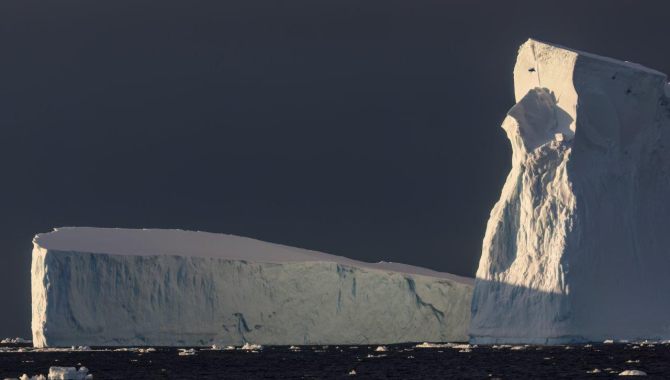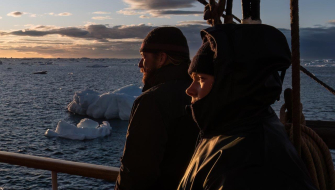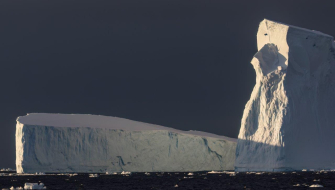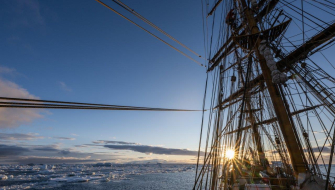Last day at sea before reaching the Antarctic Peninsula.

Sunset in the Antarctic Sound. Passed midnight. Yet another straight line shows up on the radar. First thinking of an extension tongue of drifting sea ice from the Weddell, soon it becomes apparent that we are heading straight towards a large tabular iceberg. It shows a side of a length over 10nm, over the threshold to get a code-name. It is the A76n. A piece broken up from the original A76 that calved from the Filchner–Ronne Ice Shelf in the eastern Weddell Sea in mid-May 2021. By that time it was the world's largest floating iceberg, 170 km long and 25 km wide.

But it is not the first time that EUROPA crosses paths with this iceberg of great proportions and its bits and pieces. During a trip across the Southern Ocean from Ushuaia to Cape Town in the year 2023, on the 25th of March, she sailed close to one of them. By then, it was the A76a, with a size of 78 nautical miles in length and 14 nautical miles wide. By that time, it was one of the three known fragments of the original A76.
Today we just came across the 14th piece broken up from this original one.
A change in the wind to a Southeasterly made for a slight course alteration, bringing us to pass south of it. Braces are pulled around, and the light winds that gradually pick up to a good 25kn overnight allow for setting headrig, lower and middle staysails to help the work of the engines.
The daylight brought clearer atmosphere and better visibility than what we had for most of yesterday. Icebergs of any sort and shape start becoming more numerous, as do the growlers and bergy bits. We are closing up to the tip of the Antarctic Peninsula, heading towards the Antarctic Sound.
What we will find there regarding ice conditions, weather, and winds remains still a bit of a question mark, but the idea is to spend the next day or two in this area. The ice information we have shows lots of both sea ice and icebergs drifting around the region and also some large bits of fast ice, still attached to some of the coastlines, blocking a few of the possible passages and landing sites. We will have to get there and see for ourselves if tomorrow morning there will already be a good chance to set foot in Antarctica.
But the day is not over yet. The evening brought us already to motor between the icebergs, getting to the Antarctic coasts.

South Georgia to Antarctica, a challenging sailing along the southern Scotia Arc. A crossing that has taken about 10 days, sailing as much as we could, motoring when facing adverse sailing conditions or to make westing in light winds to reach the mouth of the Weddell Sea.
A legendary region that has seen some of the great names of the golden age of Antarctic exploration in its waters. Characters such as James Cook, sent to find a continent that he didn’t believe existed; James Clark Ross, who sailed the Erebus and Terror for about four years visiting both the Ross and Weddell Seas; the Swedish Nordenskjöld and his adventures overwintering on Snow Hill Island, followed by the loss of his ship, the Antarctic, which triggered an exceptional ordeal for the survival of her crew spread over three different sites in the Weddell Sea; the sort of troubles most known after Shackleton's escapade from the death grip of Antarctica during his Imperial Trans-Antarctic Expedition; Wilhelm Filchner aboard the exploration ship Deutschland, who conducted important oceanographic research and discovered the ice shelf which has been calving some of the gigantic icebergs we have come across; William Bruce, who sailed the Scotia on a scientific trip to Antarctica, discoverer of lands deep into the Eastern Weddell Sea, charted the Antarctic underwater connections of the southern Scotia Arc of islands, and established at South Orkneys what was to be the first Antarctic Station; and most relevant to the part of the world where we are heading straight, the sealer and explorer Captain James Weddell, who in February 1823 started searching for new lands and sealing grounds east and south of the newly discovered South Shetland Islands. They penetrated the new remote southern sea some 214 miles further south than Cook had achieved in 1774, but still without any sight of land. The position where they turned back north would not be passed again until Wilhelm Filchner's scientific expedition nearly 100 years later.

And today the Europa reached the tip of the Antarctic Peninsula and started to have a glimpse of all those famed regions.
For most of the day, we found open waters with scattered icebergs. Ice conditions became denser and denser as we closed up to the Joinville Island group before turning around into the Antarctic Sound from its western entrance.
In 1838 the French expedition under Captain Jules Dumont d’Urville came across them in his expedition, first aiming for the South Magnetic Pole and then to surpass the southernmost latitude achieved by James Weddell, putting France in the game of international competition for polar exploration.
Three main islands form this small archipelago, the largest of all being Joinville, the first Antarctic lands we spotted this afternoon. Next to it comes D’Urville, and then further southeast lies Dundee.
Between the ship and their coastline extends a thick band of a mixture of icebergs of any sort, kind, and size, growlers, bits of ice, and sheets of sea ice.
Tabular after tabular, arched icebergs — on her approach from the north, the Europa wiggles her way around them on her first fabulous encounter with proper Antarctic conditions in a gorgeous sunset.
By her experience, she knows that aiming for the southern coasts of the Antarctic Sound, towards the Antarctic Peninsula, she most probably will find easier conditions to navigate.
And indeed, after the best hours of the dusk to be outside on deck, cherishing the cold temperatures, crisp air, and the low warm light on the icebergs that fill up the waters, she finds better passages of open waters there, right where she was looking for them.